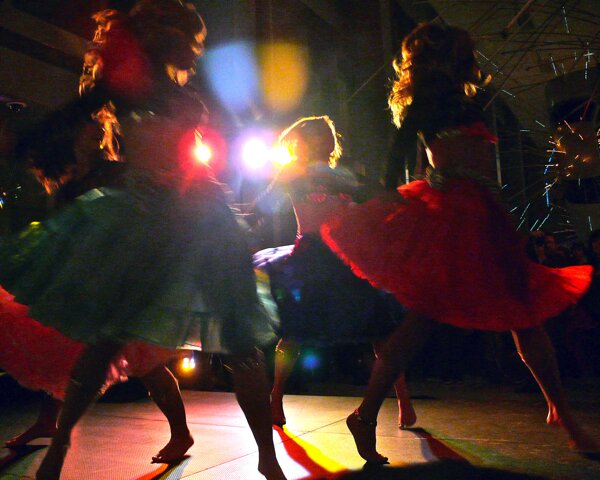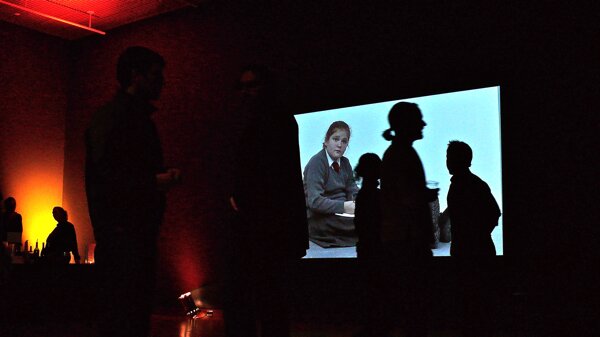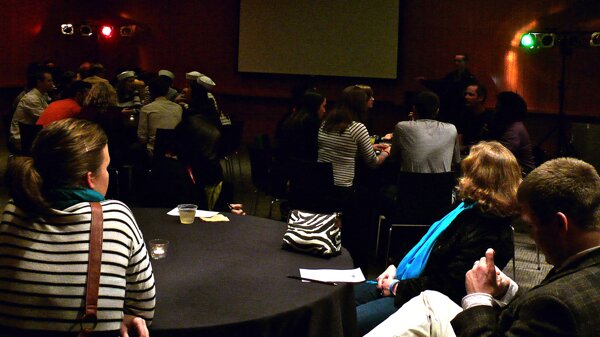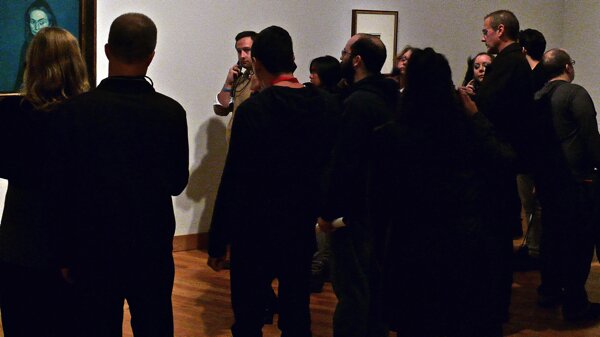Michael van Baker

About Michael van Baker:
Neighborhood: |
Capitol Hill |
Last Login: |
Online |
Joined: |
September 01, 2009 |
Profile viewed: |
2514 times |
Total Audience: |
338602 views |
| Editor & Publisher of The SunBreak | |
Storiesby Michael van Baker |
View by List | Grid |
If there's a more fun way than a Remix to visit the monumental Picasso exhibition ongoing at SAM, I'm not sure what it could be, and I suspect it isn't likely to be legal. Museum members get a special entrance and a lounge all their own, but regular people like you and me can also buy tickets (and do, the Remixes frequently sell out) and enjoy the slightly illicit thrill of taking over a museum for the night, having a drink or two, and discovering a wide range of amusements.
Here's what you missed from last night's extravaganza:
The evening began with people milling about, drinking wine and listening to the marimba-playing, chanson-française-crooning Erin Jorgensen. There was a French culture theme on account of the Picasso exhibit coming from the Musée National Picasso, but it was also Seattle-French, like it had just biked down from Café Presse on Capitol Hill.
After Jorgensen came the Harlequin Hipsters, "Seattle's premiere partner dance improv troupe." That description seems complete but it does leave out the hula hoops.
I am notoriously bad at matching face to names, but if you want to give it a shot, here are the Hipster players. As you can see, they supply the ambiance.
Then arrived the sassiness of the Heavenly Spies, whose can-can dance mastery can be viewed at the Can Can. (That's them in the first photo, up top, too.) Pernod Absinthe was sponsoring the event so as you watched the dancing, a woman circulated among the crowd offering a sample absinthe spoon.
But it was not all DJ TigerBeat's dance music (with impromptu singalong by Seattle's young and chic to "Livin' on a Prayer"); up on the fourth floor you could wander the galleries to harp accompaniment, only to notice the songs were oddly familiar--anything from arrangements of Katrina and the Waves' "Walking on Sunshine" to The Eagles' "Desperado." Chilling.
You could watch video of a Dutch girl very hard trying to sketch a Picasso.
You could play trivia. If you're wondering about the sailor hats at the far table: The first 50 people wearing a sailor's outfit got in free. Almost everything about the museum experience is improved by having 50 people in sailor outfits wandering about.
You could have your portrait taken.
Or you could take the Portrait Challenge, and draw one yourself.
Portrait Challenge accepted! Kanye and bug-Kanye.
Crowds thronged the Picasso exhibit itself, of course. Everyone got a ticket with a 20-minute window, so that you could still move about. The exhibit comes with accompanying audio narration, which you listen to on "wands" that are about the size of an opened clam-shell cell phone. They're very popular, but you can also see that the attentional bottleneck that makes cell phone listeners bad drivers extends to walkers, too. The Remix may be over, but the Picasso exhibit runs through January 17.
 Our annual social hour and fundraiser for Northwest Harvest is tonight, November 15! Visit our Facebook invitation page for more details and to RSVP.
Our annual social hour and fundraiser for Northwest Harvest is tonight, November 15! Visit our Facebook invitation page for more details and to RSVP.
Join the writers and readers of such blogs as Rainier Valley Post, SouthendSeattle, CD News, Capitol Hill Seattle, and Seattlest for some fun with YouTube, a beer tasting courtesy of Newcastle Brown Ale*, and a limited supply of complimentary pizza from Tutta Bella.
This year we're going to be meeting up in Columbia City, at the Bourbon Bar (4916 Rainier Ave. S.) from 6 to 9 p.m.
If pizza and beer isn't enough, know that the Bourbon Bar also has a new bar menu of small plates and, you guessed it, a wonderful selection of bourbon.
We're also hooking the bar's TV up to the internets for the evening, so help us build a YouTube playlist by posting your favorite(s) in the comments.
All of this for just a $5 suggested donation at the door, or two cans of food. See you there!
*Please enjoy the one and only Newcastle Brown Ale responsibly.
I can't attend "Journalism: a.WAKE.ning?" this Monday, November 15, because I'll be one of the hosts of BlogsGiving, but if I weren't, I'd be in the audience in the Upstairs Gallery at Theatre Off Jackson.
The evening kicks off at 7:30 p.m. As you enter you'll be presented with the choice of champagne or a shot of rye, symbolic of the question: "Are you celebrating a revolution in journalism or dancing on its grave?"
"I may just stay sober," playwright Paul Mullin told me on the phone. "I don't know which way it'll go."With NewsWrights United's second Living Newspaper production coming up in February, The New New News, Monday night is both promotion and fundraiser. Mullin sees the Living Newspaper model as a way to inject some much-needed life into theatre, writing:
Happily, when we produced our first edition It’s Not in the P-I: A Living Newspaper about a Dying Newspaper, we noticed an added bonus. The people came—and we sold out nearly every night—not to see excellent theatre adeptly presented by trained professionals but rather stories about a local newspaper that they loved (or hated) that had died recently.
After a preview scene comes a panel discussion on new media and journalism, moderated by NewsWrights producer Tom Paulson and featuring Pulitzer Prize-winning political cartoonist Dave Horsey (Seattlepi.com), Monica Guzman (Intersect.com), Josh Feit (PubliCola), sportswriter legend Art Thiel, columnist Brendan Kiley (The Stranger), and Chris Grygiel (coordinator of political coverage for the Seattlepi.com blogs). Tickets are $20 via Brown Paper Tickets or at the door.
"We're a hotbed of online journalism," said Mullin. "Big stories are happening in our backyards." He mentioned WaMu's downfall, the Maurice Clemmons police shooting. But the biggest story may be the media that covers those stories: Both the Seattle Times (which won a Pulitzer for its Clemmons coverage) and Seattle Crime were heads-down on that story for days on end, Seattle's de facto paper of record and a niche journalism start-up hustling to break news. (For the new production, the Newswrights turned to Facebook for leads.)
As for the Living Newspaper, Mullin said that format allows Newswrights United to explore the emotional value of news stories. News is often delivered in an emotion-free way, but at It's Not in the P-I, Mullin felt, they found a way into the public mourning of an institution as it passed away. (Here's David Horsey's review.)
"We're pro-am," said Mullin, noting their actors are a combination of Seattle stage veterans and student actors. In February, they'll be "touring" Seattle with The New New News, with stops at the South Seattle Community College, Erickson Theatre on Capitol Hill, and North Seattle Community College.
 "Admiral Junction" (Photo courtesy Flickr pool member smohundro)
"Admiral Junction" (Photo courtesy Flickr pool member smohundro)
Neighborhood Headline News
- Seattle grapples with redefining graffiti (My Ballard)
- Past and present: Chickens in the basement (Beacon Hill Blog)
- Visiting Belltown's Last Dive Bar with Igor Keller (Belltown Messenger)
- Belltown Wildlife Sightings (belltownpeople)
- Secret Service: Credit card fraud wave tied to 'one Capitol Hill restaurant' (Capitol Hill Seattle)
- Public weighs in on Metro task force recommendations (Central District News)
- TOPS@Seward School in news: District ranking, draft geographic zone are released (Eastlake Ave)
- Warning about rash of car break-ins (Fremont Universe)
- McGinn's End Run on Nickelsville: Confusing (Blogging Georgetown)
- No charge for collection of extra leaves during month of November (My Green Lake)
- Meeting with FAA next Thursday (Magnolia Voice)
- What IS this mysterious street work? (Maple Leaf Life)
- Manhunt at Woodland Park Zoo Friday night (PhinneyWood)
- It’s official: QA gym will remain open (Queen Anne View)
- Color-Coded Map Illustrates Striking Disparity Between North & South Seattle Schools (Rainier Valley Post)
- Beauty Biz & Hair Culture in the Southend (Southend Seattle)
- The thin line between graffiti and art (South Seattle Beacon)
- Nickelsville keeping its next move under wraps (U District Daily)
- Farmers market site discussion under way (My Wallingford)
- Grocery workers’ contract talks to resume next week (West Seattle Blog)
-
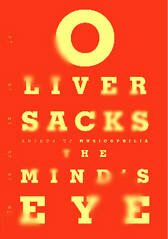 About half of Oliver Sacks' The Mind's Eye is precisely what you've come to expect from the physician and professor of neurology and psychiatry: firsthand case studies of people facing unusual neurological obstacles, delivered by a kindly, curious observer.
About half of Oliver Sacks' The Mind's Eye is precisely what you've come to expect from the physician and professor of neurology and psychiatry: firsthand case studies of people facing unusual neurological obstacles, delivered by a kindly, curious observer.
A pianist has a degenerative condition that is slowly robbing her of the ability to read music (or anything else), another is stricken by aphasia following surgery to remove a blood clot. An author has a sudden stroke and loses his ability to read and remember much, but compensates by learning to read with his tongue; somehow, tracing the shape of letters with his tongue results in comprehension of the word he's spelled. If you're a long-time Sacks reader, you may find yourself learning less about neurology than the surprising amount of coping skills that people can marshal in these instances.
But in chapters titled "Face-Blind" and "Stereo Sue," more about Sacks himself creeps into the narrative. "I have had difficult recognizing faces for as long as I can remember," writes Sacks, admitting to what's known as prosopagnosia. "...I think that a significant part of what is variously called my 'shyness,' my 'reclusiveness,' my 'social ineptitude,' my 'eccentricity,' even my 'Asperger's Syndrome," is a consequence and misinterpretation of my difficulty recognizing faces."
As it turns out, there's a broad range of face recognition ability; at one end of the spectrum are people who can recognize the person who served them coffee once three years ago when they pass them on the street, and at the other are people who mistake their wife's head for a hat.
In telling the story of Sue Barry, the woman who against all expectation gained stereo vision, Sacks details his own lifelong fascination with stereo viewers (he was a member of the New York Stereoscopic Society). So it's with some upset, turning the pages of "Persistence of Vision" that you discover (along with Sacks, it's written as excerpts from his diary) that the author has an ocular melanoma, a millimeter from the fovea.
All at once, the guiding, imperturbable physician becomes a typical basketcase patient, fighting against mood swings and dark prognoses, full of anger and regrets. When a laser treatment removes his stereo vision, you feel it keenly. And by page 200, you have a much greater sense of what coping skills can and can't accomplish. As Sacks' vision is not expected to much improve--the reverse is true, in fact--his final chapter on blindness and the "mind's eye" is doubly poignant.
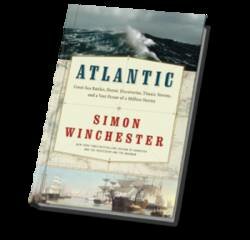 Since I'd briefly put down Simon Winchester's Atlantic: Great Sea Battles, Heroic Discoveries, Titanic Storms, and a Vast Ocean of a Million Stories to read from Mind's Eye, it was funny to see him pop up in Sacks' book on page 165.
Since I'd briefly put down Simon Winchester's Atlantic: Great Sea Battles, Heroic Discoveries, Titanic Storms, and a Vast Ocean of a Million Stories to read from Mind's Eye, it was funny to see him pop up in Sacks' book on page 165.
Convalescing after his eye surgery, Sacks puts down in his diary: "Have just written to Simon Winchester, telling him how much pleasure I have got from listening to the audiotape of his book Outposts. [...] I have been a reader all my life, and am not fond of being read to, on the whole. The Simon Winchester was a pleasant exception to the rule." (You, too, can listen to some Winchester audio here.)
The pleasure of reading Winchester, a British geologist turned journalist and author, is remarked upon widely. The preface to Atlantic is positively Dickensian in its portentous yet conversational tone: "The ocean romance that lies at the heart of this book was primed for me by an unanticipated but unforgettable small incident. It was a clear cool dawn on Sunday, May 5, 1963, and I was eighteen years old. I was alone, on passage aboard a great ocean liner...."
The rest of the book, which charts the Atlantic's history from "The Beginnings of its Goings On" to "Falls the Shadow, Fades the Sea," is almost never anything less than entrancing in its erudition, historical sweep, and retailing of maritime yarns. A glossary of "possibly" unfamiliar terms includes bollard, curragh, cyanobacteria, hammada, loxodrome, pelagic, quinquereme, snood, and taffrail. There are more terms you'll have to look up on your own, as well.
Confronted with the vast eras of time an ocean's lifespan encompasses, one of Winchester's most troublesome tasks was trying to find a way to organize the book so that he could consider days and epochs in its pages without giving the reader whiplash. His solution should delight English majors, if nothing else, because he builds his biography of the Atlantic around Shakespeare's seven stages of life, from the As You Like It monologue that begins, "At first the infant, mewling and puking in the nurse's arms...," and ends with "second childishness and mere oblivion; sans teeth, sans eyes, sans taste, sans everything."
While Winchester doesn't stint on the long, geologic view ("The final moment of the Atlantic's existence will come in about 170 million years"), his primary concern is with the relationship of humans with the ocean, from the early Phoenician sailors of the African coast to the Norsemen and Irish who put to sea (thus the curragh in the glossary). You learn about the golden age of Atlantic of cartography (including Benjamin Franklin's mapping of the Gulf Stream for the benefit of the postal service), and trade and piracy, slaveships and windjammers. There are mighty naval battles and whaling fleets and telegraph cables stretched across the deeps.
Too soon, Winchester recounts how the British government dumped almost thirty thousand tons of highly radioactive waste into the Atlantic at "a specially selected site four hundred miles west of Land's End," and how a ocean-wide contamination (mercury, PCBs, cyanide, pharmaceuticals) has since occurred. And of course there's the vicious toll that industrial fishing has taken, and last but not least, climate change.
Interspersed throughout all of this are journalistic touchdowns that dispel any mustiness of history. These enter early on, with a visit to the island of Mykines in the Faroe archipelago:
I was sitting on the cliff edge, my legs dangling over half a mile of emptiness. I was facing due west. Just below me were clouds of seabirds, the gannets and fulmars, kittiwakes and storm petrels, and beside me were the chattering congregations of puffins. Ahead of me there was just nothing--just an endless, crawling sea, hammered like copper in the warm sunshine, and stretching far, fifty miles, a hundred....
Later, during his recounting of the Falklands war, Winchester details his own imprisonment as a suspected spy, and how his captor looked him up years later to apologize for his delight in telling Winchester about the sinking of the Sheffield, having breached an unspoken sailor's code. These are things that only Winchester can tell you, as in the epilogue, when he describes his visit to the place a cargo carrier wrecked off Skeleton Coast in 1942, with a crew of 64 and 21 passengers. The remnants of the wreck, when Winchester finds them, are rusting and sinking in sand. "Beyond the breakers, the green Atlantic growled on, restless and eternal."
- Simon Winchester appears at Town Hall at 7:30 p.m. on November 17.
That would be news to anyone who's spoken with the state legislature. The latest lawmaker to go on record vowing to make Seattle pay for any excess costs is Rep. Larry Seaquist, a Democrat from Gig Harbor. Seaquist told the Seattlepi.com, "I will be among those who make damn sure that deal stands in place. We bought our own bridge, you can buy your own tunnel" (a reference to funding of the second Tacoma Narrows Bridge).
Gov. Gregoire has mounted lawyerly arguments against the possibility of cost overruns, saying things that sound like there's little possibility of such a thing ever happening, and heaping scorn on McGinn as a foot-dragger. "What could cause a cost overrun? Delay," said the governor, despite the fact that, when it suits WSDOT, a year's extension to the project's timeline is spun as bringing costs down.
Gregoire has also called the specific provision "unenforceable," which may be technically true. But it's also disingenuous. The Legislature is perfectly capable of writing an enforceable provision, and Sen. Jim Kastama (another Democrat) went on record over a year ago to say, if costs exceed the budgeted amount, Seattle will pay. Note that these are both Democrats, and that recent Republican wins have cut into the Democratic majority in both House and Senate.
So why should we trust the governor on this issue? She's minimized evident risks, cast aspersions on those who questioned the soundness of the project's funding, and moved goalposts as needed--but the provision that signals the Legislature's intent to make Seattle pay for cost overruns has never gone away, and nor have the legislators who insisted on it. Only in politics would it be an insult to point that out in public.
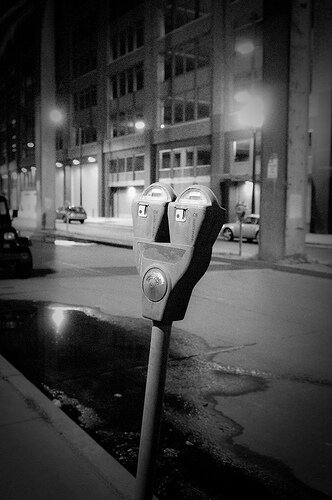 Photo courtesy Flickr pool superstar Slightlynorth
Photo courtesy Flickr pool superstar Slightlynorth
The City Council is going along with Mayor McGinn's plan to raise parking meter rates in Seattle, to as much as $4 an hour, but won't increase the parking tax rate paid by private lots and garages. They're also calling for two parking studies: one to determine the best rates for neighborhoods, and one to follow up on Tim Burgess's interest in dynamic parking pricing. (Here's his parking op-ed with Mike O'Brien.)
Nothing about the budget process is likely to be uncontroversial, but so far only PubliCola has paid much attention to the Council's tentative approval of City Attorney Pete Holmes' try at belt-tightening. Holmes wants the city to halt "a longstanding contract with private law firm Stafford Frey, which defends the police department in tort cases." He claims that many cases can be handled by city attorneys for about one-third the cost of Stafford Frey's billings, though the city will open more complicated cases for bid.
The savings could amount to $1 million. But as Dominic Holden reports in the Stranger, Rich O'Neill, president of the Seattle Police Officers' Guild, has threatened to sue the city if the union doesn't get the more pricy representation.
"Over the last six or seven years, this was a real hot potato," the Council's Nick Licata told Holden. It still is. But a $67 million deficit may have the last say.
 The Defense Video and Imagery Distribution System (DVIDS) alerted us that they've got some holiday greetings from Washington residents on duty for the Army and the Marines in Iraq, Afghanistan, and Kuwait. Two soldiers are from Yelm, one from Richland, one from Moses Lake, and one from Fort Lewis.
The Defense Video and Imagery Distribution System (DVIDS) alerted us that they've got some holiday greetings from Washington residents on duty for the Army and the Marines in Iraq, Afghanistan, and Kuwait. Two soldiers are from Yelm, one from Richland, one from Moses Lake, and one from Fort Lewis.
They've taped tiny little videos saying hello to the home front; if you're from the area, you can send an E-card back by visiting the video page.
It's also Veterans Day, and while some things are open and some are closed, some businesses are giving back. Veterans can enjoy free meals, free car washes, free music, and free museums and parks. Veterans who get hungry on the go can pull into a Dick's Drive-In, flash their military ID, and order a free hamburger.

The Boeing Company has called a halt to test flights of its 787 Dreamliner, after an electrical fire "affected the cockpit controls and the jet lost its primary flight displays and its auto-throttle," reports the Seattle Times. The plane made an emergency landing in Laredo, Texas, with 42 people on board.
A lot depends on the cause of the fire, and whether it was a simple equipment malfunction or was the result of a more serious design flaw.
Either way, says the New York Times, "[s]everal analysts said they doubted that Boeing, which is counting on the jet to vault past in total sales, would meet its deadline to deliver the first 787 by next March."
Every story in the media takes the opportunity to mention that the Dreamliner is almost three years behind schedule at this point, thanks to Boeing management's attempt to outsource the company's supply line. Multiple issues with Italian manufacturers and even a problem with the work of the venerable Rolls Royce engine-makers have thrown the 787's ship date drastically off schedule.
In hindsight, you can see that Boeing executives traded a situation in which they had quality assurance but uncertain costs, for one with much more variable quality assurance and costs. It's ironic that Boeing, steaming over a two-month strike delay in 2008, made such a public show of siting a new 787 assembly line in South Carolina. Where will they site a new corporate headquarters now that it's clear the old one is the driver of decisions that now threaten the company's future in commercial air?
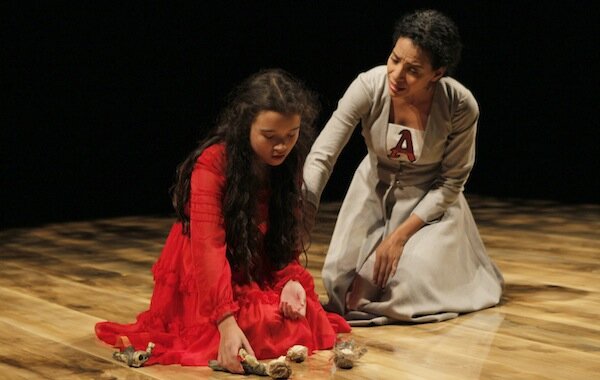 Izabel Mar as Pearl and Zabryna Guevara as Hester (Photo: Chris Bennion)
Izabel Mar as Pearl and Zabryna Guevara as Hester (Photo: Chris Bennion)
"I learned about my family in bits and pieces," playwright Naomi Iizuka said in an interview. "There are things that still peek out in the telling, like my father's sister will tell me something he neglected."
Similarly, you only get bits and pieces of Hawthorne's story in her play The Scarlet Letter, showing at Intiman Theatre (through December 5).
Audiences I think would be better served by knowing that Iizuka's work is to Hawthorne's as Kaufman's Adaptation is to The Orchid Thief. (Except that Iizuka's adaptation runs just over 70 minutes; you've hardly sat down, it seems, when everything is all done.) In both cases, the adapting author has introduced a significant personal element into the source. Here, that includes a paraphrasing of that "bits and pieces" line by the adult Pearl (Renata Friedman) who introduces and narrates the proceedings.
It's not a satisfying reworking, in that it hardly improves upon the original, and never makes a bold claim for its new existence--just like the little Pearl in the play who would like to be noticed but doesn't realize the attention the town fathers pay her is not for her sake.
Rather than a Puritan costume drama, what you see is a sort of memory play--part imagination, part hallucination--in which Pearl tries to recover her father, and make peace with the choices her mother made. (Tangentially, I direct you to Susan Faludi's "Feminism's ritual matricide.") Where Hawthorne's story is driven by Hester's conflict with Puritan society, Iizuka's play is not driven much at all, though it pretends to be (by a repressed memory that arrives right on cue).
Peter Ksander's beautifully austere set, lit by Justin Townsend, features a wooden square backed by a row of white birches that immediately suggest bars. There's also a wooden scaffold, in which the disgraced Hester (Zabryna Guevara), babe in arms, faces down her would-be tormentors, railing loudly in defiance, and refusing to name the father.
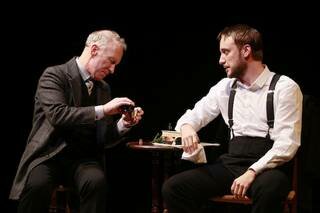 R. Hamilton Wright as Chillingsworth and Frank Boyd as Dimmesdale (Photo: Chris Bennion)
R. Hamilton Wright as Chillingsworth and Frank Boyd as Dimmesdale (Photo: Chris Bennion)
Director Lear deBessonet supports Iizuka's disjunctive adaptation--in which people with the names of Hawthorne's characters appear and have abstracted, present-day conversations and conflicts--by having the townsmen (Mark Anders, Jose Gonzales) play townswomen, too. They gossip and criticize Hester, sometimes comically. (The presence of a roving violinist, Emily Holden, is unexplained, but the music is nice.)
Iizuka's language, too, has little in common with Hawthorne's novel. Here's one of Hawthorne's righteous battle-axes:
This woman has brought shame upon us all, and ought to die. Is there not law for it? Truly, there is, both in the Scripture and the statute-book. Then let the magistrates, who have made it of no effect, thank themselves if their own wives and daughters go astray!
Iizuka's townswomen might call Hester a hussy and whore, but they are bitchily impotent, and register less and less as the play moves along. It's only when they aren't there (a scrim falls) and disembodied voices insult and attack Hester, that their wounding presence is recast in a way that retains the sense of danger.
But otherwise, the dramatic stakes are reduced, again and again, in episodic "bits." Hester argues with her once-lost husband Chillingworth (R. Hamilton Wright) as if he's an almost-ex who won't sign divorce papers, adult Pearl challenges Hester about being a cowardly, codependent woman, and young free-thinking Pearl (Izabel Mar) spouts off at every turn to everyone. When she and Hester get hauled before the town fathers, it feels like a parent-teacher conference indictment of single moms. In an exception, Chillingworth's preying on Pastor Dimmesdale (Frank Boyd) is grimly sublimated aggression, and its pathological nature culminates in a startling fever-dream image.
